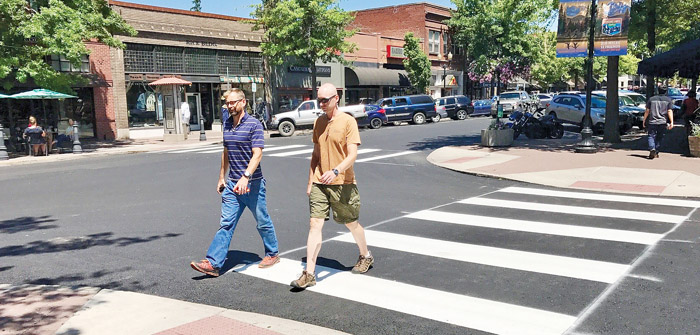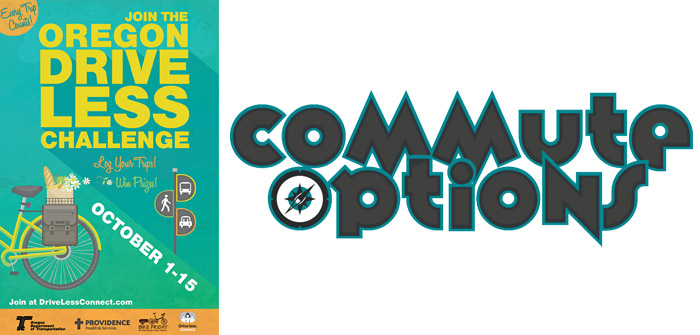Just how walkable is Bend? Very much so, and the city’s walkability is increasing all the time. Recently designated a Walk Friendly Community at the Silver level by the Pedestrian and Bicycle Information Center, the city is showing its commitment to improving and sustaining walkability and pedestrian safety through comprehensive programs, plans and policies.
The May 2013 designation means Bend is one of 36 Walk Friendly Communities (WFC) nationwide. The WFC program encourages towns and cities across the country to establish or recommit to a high priority for supporting safer walking environments. The program, sponsored by the US Department of Transportation (USDOT) Federal Highway Administration (FHWA) and FedEx, recognizes communities for making a wide range of improvements related to walking, including safety, mobility, access and comfort.
Many of the improvements to Bend’s walkability are direct effects of work by the Bend Metropolitan Planning Organization (MPO), which provides transportation planning for the City of Bend. Following national and local trends towards more bike and walk-oriented modes, the Bend MPO has been working behind the scenes for some time to create a more balanced transportation system.
“We have a very walk-friendly code that helps improve walking environments,” said Robin Lewis, transportation engineer with the City of Bend. The current code, redeveloped around five years ago, mimics the state’s model development code and is designed for better connectivity between neighborhoods and more comfortable walking environments.
“Instead of having to get into your car to travel short distances for errands or work, Bend’s connectivity portion of the codes should allow you to walk there,” said Lewis. Wide sidewalks (6’ on busier streets) – buffered with a planter strip and street trees – can attract more people walking because of the more enjoyable and inviting atmosphere that the code requires.
Encouraging people to walk instead of drive decreases the wear and tear on existing roadways, saving the City of Bend money over time. But improving conditions to allow citizens to walk has many more positive ramifications for the community. Walking – as a mode of transportation – has been shown to positively affect the community’s health, environment, economy, quality of life and sense of social justice.
One of the main projects under implementation by the City of Bend – completing and repairing sidewalks – makes walking more accessible to everyone. Four main corridors – on NE 27th, NE Eighth, Newport Avenue and Wilson Avenue, have been identified for sidewalk improvements over the next two to three years. Another project develops a prioritized needs list, which will set the stage for sidewalk work over the next decade.
Better sidewalks, with ramps and curbs, are helpful for all segments of the population, and are especially crucial for the elderly and persons with disabilities. The City of Bend has an ongoing curb ramp installation program in effect, in order to gain ADA compliance. About 200 curb ramps have been constructed annually for the last eight or nine years, according to Tyler Deke, manager for the Bend MPO, for a total of around 2000 new ramps in that time.
“Complete sidewalks make walking for kids easier too,” said Deke. “The more we can get kids walking and biking to school, the less the school district has to spend on busing,” he said. It has also been shown that when kids get regular exercise – like that of walking and biking to school – they have lower incidences of obesity and its health repercussions.
Making multi-lane road crossings safer for those who walk is another City of Bend priority. “We will be developing corridor plans for where we need to enhance crossing opportunities, with provisions of high visibility signing and pavement markings or flashing warning beacons,” said Lewis. Roads with multiple lanes, like Third Street and Greenwood Avenue, and one-directional roads, like Wall Street, Bond Street, Colorado Avenue and Arizona Avenue, are slated for the planning process. “It is possible that some four and five lane roadway segments could be narrowed to three lanes given their lower traffic volumes, which will improve the safety of crossing those streets,” she said.
All of these improvements are meant to encourage more walking, therefore improving transportation efficiency. “If we can use the same infrastructure to carry more people, it’s more efficient,” said Lewis. A 2009 U.S. Department of Transportation study showed that 28 percent of trips in the U.S. are less than one mile. “If some of these trips were walking trips,” said Lewis, “there would be positive consequences to our health, environment and quality of life, and a reduction of demand on roadways.”
Commute Options promotes choices that reduce the impacts of driving alone. For more information about Commute Options, contact Jeff Monson, Executive Director of Commute Options at 541/330-2647 or visit www.commuteoptions.org.
Annissa Anderson is a freelance writer and PR consultant in Bend.




